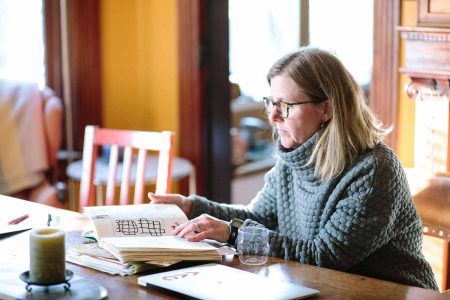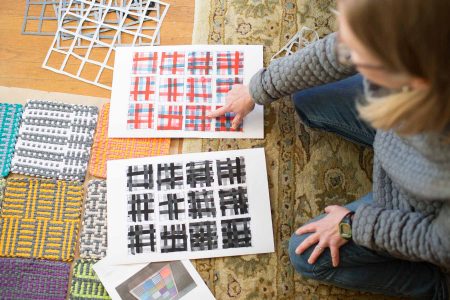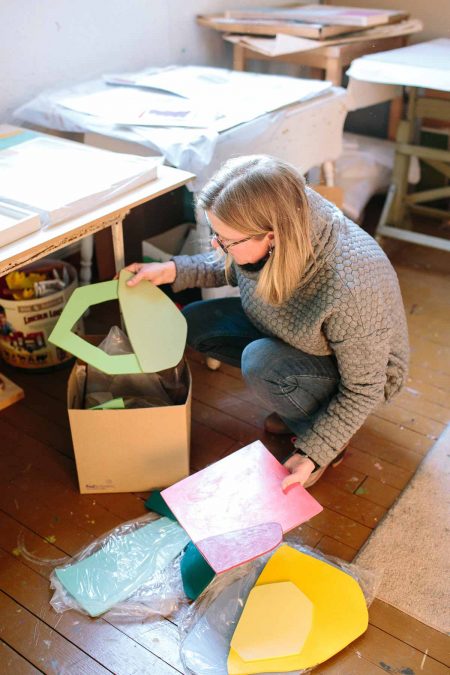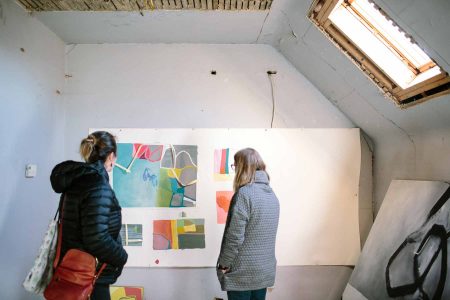Editor’s Note: Aeqai is pleased to republish Megan Bickel’s interview with Paige Williams. The inverview was originally published on Five-Dots.
Paige Williams has exhibited in Germany, the Ukraine, Chicago, Los Angeles and New York and has been selected as an Artist in Residence at the Millay Colony for the Arts in New York, The University of Alaska, and The Neu Rathaus Gallery in Munich, Germany.
Paige is a Studio Program Chair at the Art Academy of Cincinnati and has been instructing, challenging, and encouraging students within AAC’s walls since 1997. Outside of teaching, she has an active studio practice out of her home in the Northside neighborhood of Cincinnati, Ohio.
Her work varies in subject matter and reference material; but always seems to hold a quirky, smart, colorful and challenging sensibility that is both approachable and distancing.
Five-Dots: How long have you been in this studio?
Paige Williams: I have been in my house since 2001. I had a studio on Main Street for ten years and then I got pregnant, and I figured that once I have a kid there would be no way for me to just go back and forth. So I decided to move it here. So I guess it’s been fifteen years.
F-D: When you moved in here, did you have an idea for how you wanted to lay it out or did it develop organically?
PW: It’s developed organically. I had the attic space in mind because it’s the rawest, dirtiest space. But because it’s not heated or air conditioned, I can only really work up there in the spring or fall. So it’s become the messy area and the storage area. But I have my office on the second floor. In there I do some painting, like, smaller stuff, and then other construction, and drawing, that kind of stuff. Then, depending on the situation, I’ll work down here at the kitchen table. I’ll work down here if Max [my son] is working on his homework or whatever– I’ll just come down here if I don’t want to be locked away in a room somewhere. It’s whatever the need is, really. As long as I can keep making work then I’ll just find a spot and make stuff there.
F-D: Since you say you mostly work in the attic in the spring and fall, do you think that you do a lot of prep or exploratory work in the winter and summer, perhaps as a consequence?
PW: Yes, [the perfect example] is when I had a show at the Weston. . . I did a lot of sketching, I mean just sketchbook after sketchbook, so that when I had the opportunity up there I was just ready to go. It also just coincided that Max’s spring break off is different from mine. And so I have a week all to myself. I guess that’s one thing that has changed about my process. I just try to be absolutely ready. . . I make sure that I have the materials, that my ideas are ready. . . everything. I have to be able to hit the ground running. I definitely do more preparatory stuff when school is in session.
F-D: Has the location of the studio influenced your work in any way?
PW: I think so. I mean, definitely when I’m in the attic. I’m more willing to make a mess, and I’m more willing to work large. And so that kind of work happens up there. Oil painting, and larger messy things. And then, if I can’t or don’t want to work up there, then I work on smaller things or pieces of things. Multiple small things, or small things that might work together.
F-D: Has working in Northside affected anything, or being in a neighborhood? Or being in Cincinnati. . .
PW: I don’t think so, if I travel then my work is affected by things that I see. But other than that no. I take walks a lot. I look at formations of branches and woods and stuff like that but I don’t think that’s specific to right here.
F-D: Can you describe a typical day for yourself in the studio, or a typical work week?
PW: I don’t have days in the studio anymore. I don’t have time to sit and contemplate life and art and. . . I have to be ready to work. I’m not good at coming up with ideas, but I am getting better at it due to this time constraint that I have now. I don’t know if this is applicable to this question, but I was listening to this interview with Dar Willaims, who is a singer-songwriter, and the interviewer asked her, you know, “how does the inspiration hit?” And she said that she doesn’t get big lightening bolts of inspiration, she gets little sparks. But she said that she found it easier to be inspired when she surrounded herself with the right things. She needed the right amount of high art, low art, and no art. High art is going to museums, low art is going to Julia Roberts movies in the middle of the day by herself, and no art is taking long walks in the woods. And so I think that you need to feed yourself as an artist. Looking at art, doing research, reading, being with family, whatever you need to keep your life in balance so that you can make. And I know that you have to schedule yourself studio time so that you do it. But if I have too much on my plate then I kind of step back. I’ll make sure that I work in my sketchbook for half an hour or something, but I try not to force it. I also like to eat and look at my work. I’m more of a morning person. I’m not one of those people that can just pull all nighters. I don’t like working when it’s dark. My optimum time for working is like 10 am until like 2.
F-D: How would you describe your subject matter or the content of your work?
PW: Well, my work is non objective; but it is based on things that I see. I don’t just make it up out my head. I think that that is a big misconception about artists that work non-objectively: that the work isn’t based on anything. I look at stuff all of the time: it might be the shapes of negative spaces on the bottom of a chair, or branches, or interesting lines that I see. The other day I opened the oven and saw the grid [of the rack] and so I took some pictures and did some drawings from that. The grid has always been interesting to me. My dad was an architect and we used to always drive around and look at houses, which I hated. But I think that all of that looking at structure and windows, doorways, fences, exits and entrances [influenced me]. The grid is a pretty recognizable structure. And so if I make one line wonky, it’s obvious. I don’t come up with a narrative, but I do think my work has meaning. I usually just figure that out afterwords by looking and visually explaining it to myself. It’s usually directly influenced by whatever is going on in my life.
F-D: Do you think about the idea of the barricade at all when your thinking about grids. I’ve always noticed a play between transparency and a sort of ‘blocking off’ within your use of the grid, and I wondered if that was just a projection that I was placing onto the work or if that was something that you thought about.
PW: Yea, I see it as keeping things in or out. It can be seen as a positive or a negative. As a positive it is protective and keeps things in, negatively it’s keeping out some kind of force. But a lot of barricades have gates. And I do like transparency, I like materials that I can see through and build onto. I love tracing paper. Yes, that’s pretty true I suppose.
F-D: What mediums do you work with?
PW: Traditionally I’m a painter. I’ve used all kinds of paint: oil, acrylic, latex house paint, gauche, watercolor, ink, flash, I don’t think there is any painting medium I haven’t really worked with. I draw a lot, especially in my sketch book: graphite, colored pencil, marker, whatever I can find. . . ball point pen. Lately I’ve been working a little bit more three-dimensionally: I did the woven pieces on the pot holder loom, I’ve built a structure to put them on. And then lately more non traditional art materials: pipe cleaners, felt, cut shapes out of wood, foam.
F-D: Can you delve into what spurred you on into working with textiles?
PW: Most, if every new thing that I do within my work comes from being stuck. And I just try to go for something that sounds fun. I mean, it sounds kind of trivial, but I’ll just go through the grocery store, Michaels, Target, wherever. . . and I’ll kind of look for something that looks like fun. I crave materials like I crave certain foods. Your body kind of knows what it needs in the same way that I think my art self knows what it needs more than I do in my head. And so I’ll think, “oh, powdered charcoal sounds like fun” and so I’ll get it and try to make something with that. Recently I made a list of weird stuff that I can try to make art with, while trying to not judge myself too harshly for it. I think it had pipe cleaners and nail polish and pot holder loops, toothpicks. . . . and I ended up seeing some pipe cleaners online and at Target and so I just got them. And I made some dumb stuff, and I made some stuff that I still found dumb but also found kind of endearing. So it’s just forcing myself to react to something new. And when your working with a new material it forces you to go about it in a different way. Which I think is healthy.
F-D: Do you find that your work becomes kind of cyclical?
PW: Yes! When I was in grad school, Frank Herman, one of my professors, walked into my studio and I kind of just yelled at him that I was making the same work over and over. I was just going in a circle. And he said that it wasn’t a circle– it was a spiral because I was revisiting the same thing but I was in a different place. So that made me feel better, I didn’t feel [so much] like I was going backwards. I [revisit] black and white a lot. I love color but every once in a while I’ll remove it and it becomes so liberating because I don’t have to think about it. You have black and you have white. Then I’ll go back to color.
F-D: Can you tell us more about this process and how it has evolved?
PW: It has evolved in that I don’t have the long spans of time where I can sit and think about it.
F-D: Did you ever have that though?
PW: I mean yes. I’d spend Saturdays and Sundays in the studio or I’d go after class. I had it, but I don’t think I was ever good at working in that way. I’m impatient. I know that you have to put in the time, and you have to show up. But people work in different ways. And I’ve always worked in spurts. I like working on multiple things at once. I don’t like having just one thing that I’m trying to figure out. Now it’s just shorter amounts of time. My media has expanded. I think that’s just from trying to keep making new things. Or not necessarily new things, but stuff that’s new to me.
F-D: Do you have narratives in mind for each piece?
PW: I have themes and threads. One is definitely this, ‘what makes us human?’, a lot of my work looks kind of awkward and vulnerable– which is where I think we are most connected. I should speak for myself, but I have some perfectionist tendencies, and when we’re not being perfect or graceful and we are wiling to share that with others and you are honest in that, that’s when we show our humanity. It’s like. . . I hate seeing people miss the bus. It really kills me. I see them running up to the stop, and the bus just drives off. And I’m thinking, that person just lost an hour worth of pay. They missed picking up there kids. Or. . . I don’t know, I think those are moments that show our humanity. I guess humor plays a role in my work. I think humor is very telling. You can’t fake laugh. You can’t tickle yourself. I guess I’m interested in genuine responses. I would never be a stand up comedian. I can’t imagine having the responsibility of making everybody in a room laugh. I also think that that has carried over into my teaching. I think that I’m more comfortable saying ‘I don’t know’.
F-D: Do you consider your work to be autobiographical at all; does personal history work its way into your art?
PW: Definitely, but I don’t think it would be recognizable for anyone else. I think that my work is ultimately about relationships. I mean, what else is there? There’s the relationship with your space, with your family, strangers, everything. It’s too big of a basket to throw everything into. But I think I look at the relationships of line and shapes in an effort to discuss something more conceptual.
F-D: What influences outside the visual arts inspire and impact your approach to making work?
PW: Everything I do every day. I have to run every day. I read every day. I like to travel. I usually have multiple books going at once and then I have an audio book usually going in the car. I think reading is like traveling. It puts me in a different world. I think fiction is important and good. I think you have to be open to believe in a fictional story. I don’t like science fiction or fantasy. I like things that are well written. I get a lot of my titles from books. I like historical fiction. I like reading things that have geographical references; I’ll stop and go look up wherever it is that they are referencing. I’m in two very different book clubs: one at the Art Academy and one with a bunch of moms from around here. I like being in book clubs because they’ll pick books that I normally wouldn’t pick. Teaching too. Teaching affects me. When a student has a problem or an issue, it turns into practice so that when I’m in the studio I can approach my problems quicker.
F-D: What does having a physical space to make art in mean for your process, and how do you make your space work for you?
PW: Well, like I said, different spaces work for different processes. I think having a space where you can leave your mess is really important. To me that’s the most important.
F-D: When you travel, do you bring supplies or do you just kind of put it on pause.
PW: I do, it depends. A few years back we went to Nova Scotia and I brought some oil paints and some gessoed paper. Nothing too big. If I’m gonna be gone for a week or two then I’ll be sure to take a good sketchbook, some colored pencils, some watercolors. But if it’s for a weekend or something I’ll just take my regular sketchbook. I always take something.
F-D: Is there something you are currently working on, or are excited about starting that you can tell us about?
PW: I’m excited about this project with Anne [Burrell}. She photographed my little pipe cleaner sculptures and some other stuff for me. I also produced a big digital print of some images from my sketchbook. Digital technology hasn’t really affected my work too much. But I’ve kind of come to the place of questioning why it hasn’t. . . And I feel like I need to find a way to integrate it. I think it’s so energizing that we are in a place where I can make work out of pipe cleaners one day and then something more serious the next. Forever, everything needed to look homogenous and having a distinctive body of work was very important. And I really think that that isn’t important. You don’t have to label yourself as just a sculptor or just a painter. I think it is important to find your voice or hand. But I also think it’s equally important to surprise yourself. It’s important to dig deep into something, but it’s also important to not get stuck there.
F-D: So is installation something that you are thinking about more then?
PW: To an extent. I’m thinking about other ways to present things that isn’t on a nail on the wall. Like the digital print, I’m probably going to just display it on the floor. I will probably hold them down with these little balloon weights. The question of painting is just so vast. And so I take it very seriously. And so this is just my way of playing around with seeing different objects. When I take things off of the wall, it forces me to think more about the viewer. When an object is on the floor, the viewer has to interact with it more, they have to walk around it, crouch down to it, it becomes much more physical. I’m still working within the confines of a rectangle. Even the [three-dimensional] objects that I made, I’m now getting photos taken of them, and then we are returning back to the rectangle.
F-D: Do you see your work as relating to any current movement or direction in visual art or culture? Which other artists might your work be in conversation with?
PW: I guess I’m definitely affected by what’s going on, in regards to artists feeling a bit of freedom in regards to what they are making, and perhaps I feel like I’ve been given permission to try other things because it’s going on in the art world. I always try to take stock of what I’m getting excited about. That’s why looking at other artists’ work is so important for me.I have to see what I’m gravitating to in other people’s work, and then I can think about how it is similar or different to my own work. I think I look at other artists to give me permission to do things that maybe I haven’t thought of or allowed myself to consider as a possibility.
F-D: Which other artists might your work be in conversation with?
PW: There are a lot of artists that I feel like I have things in common with, but you wouldn’t know it. I don’t know if you ever did this, but occasionally I will see someone’s work and think, ‘man, I really need to check them out”. . . and then I’ll read about them and they will be going at it from a totally different perspective. Bryce Martin is one of those for me, the work is somewhat similar in terms of line and pattern, and negative space. . . sometimes color. But then I read about him and he’s looking at Greek mythology and, you know, we just have nothing in common. And then I’ll read other artists [statements] and feel like we are totally in sync and then not be attracted to the work, or it just has nothing visually in common. My go-to’s are, you know, Richard Tuttle, Bryce Martin, Jessica Stockholder, Joan Mitchell. . .there are others that I’m forgetting, Jennifer Bartlett, Amy Sillman. And I also, I have friends who are artists who I’ve either met through residencies or shows, and I do feel like my work is in conversation with their work. Douglas Witmer, who’s out of Philadelphia. Jeff Jones, he’s from Dayton– I don’t know if you know his work. You know, we found each other because our work is doing similar things and we have similar interests.
F-D: Do you have a motto or creed that as an artist you live by?
PW: Quantity to achieve quality. You just have to make a bunch of stuff. You have to make a lot of mistakes. You have to be willing to fail– nail polish might have sounded like a great idea, but it’s actually really stupid. . . You can’t think up art, you have to start doing at some point. Conceptual art is a different thing, I’m not slamming conceptual art. But you have to start thinking outside of your head at some point. You have to try something. Also, I think it was Robert Motherwell who said, “No matter how many good paintings I get under my belt, I always have to potential to make a really shitty painting”. So I mean, there’s no guarantee. That’s why it almost feels like magic when it does happen. Another motto that I’d like to have is “why not?”. But I don’t think I live by it as much as I’d like to.
F-D: When asked; what do you tell people you do for a living?
PW: Well, it depends on who is asking. I tend to say that I’m a professor before I say that I’m an artist. I feel like when I say I’m an artist it opens up a whole can of worms. And most of the time I feel like people are looking for a specific answer that I don’t really have. I make stuff. And I’m terrible at small talk. It’s really painful for me. I also feel like art for me is very personal.
F-D: What risks have you taken in your work, or for your work?
PW: I think doing those flower paintings I did out of school were the riskiest things I’ve ever done. I think they challenged my view of myself as an artist, and that was hard to do. Anytime that I do something that has the potential to be really stupid can feel like a risk. You know, the great thing about being an artist is that you can try stuff and no one ever has to know. It’s not like being a performer and if you have a bad performance everyone knows about it.
F-D: Words of wisdom?… a motto, favorite quote?
PW: You have to get comfortable with being uncomfortable and with the fear. You just have to accept that [as an artist] this is the world that you live in. There are no guarantees. There’s no easy ride. And I think that if you’re [being authentic] you won’t want it anyway.
F-D: Are you involved in any upcoming shows or events? Where and when?
PW: I just had the Faculty show at the Art Academy. Minumental 30 is up at the Art Academy of Cincinnati, I have some stuff in that. I need to get back into that whole process. As of late it’s been a lot of just having people approach me about shows. I’ve been slacking a bit there.
–Megan Bickel







